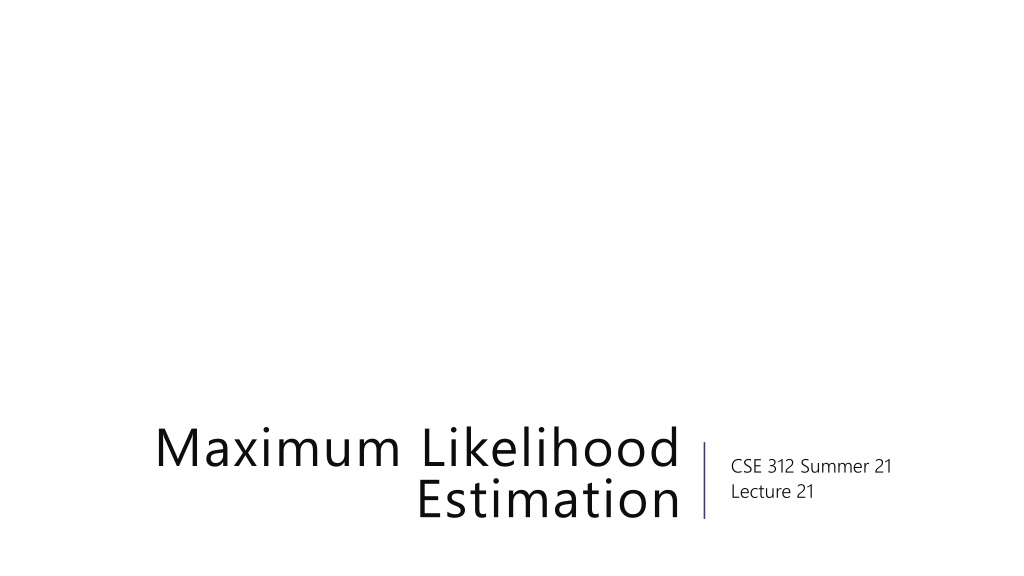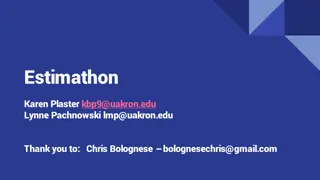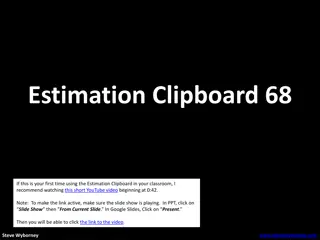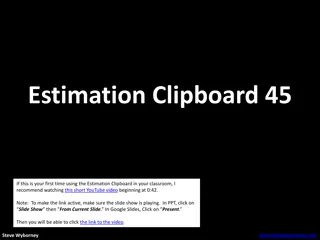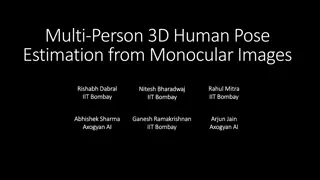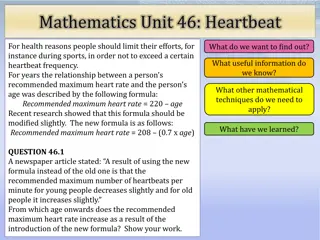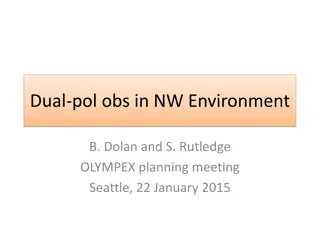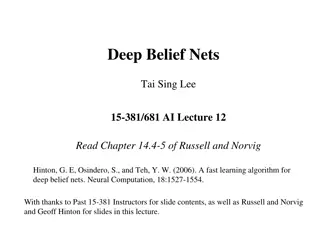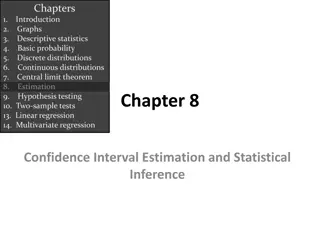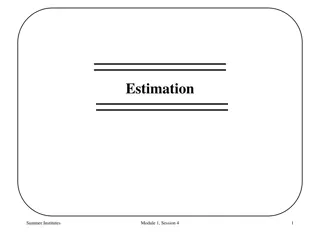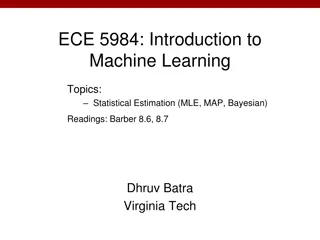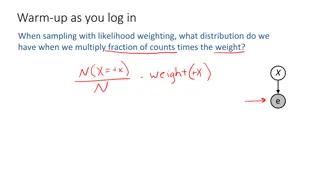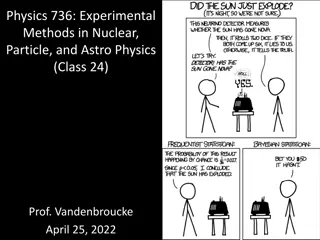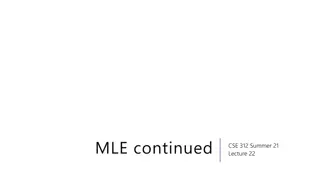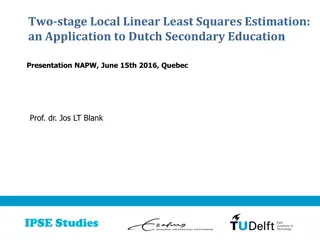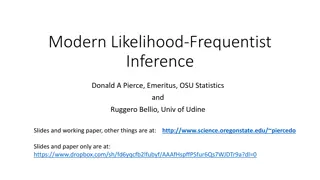Understanding Maximum Likelihood Estimation
Dive into the concept of Maximum Likelihood Estimation, where we estimate parameters based on observed outcomes in experiments. Learn how to calculate likelihoods and choose the most probable set of rules to maximize event occurrences.
Download Presentation

Please find below an Image/Link to download the presentation.
The content on the website is provided AS IS for your information and personal use only. It may not be sold, licensed, or shared on other websites without obtaining consent from the author. Download presentation by click this link. If you encounter any issues during the download, it is possible that the publisher has removed the file from their server.
E N D
Presentation Transcript
Maximum Likelihood Estimation CSE 312 Summer 21 Lecture 21
Important Dates! Real World 2 Wednesday, Aug 11 Review Summary 3 Friday, Aug 13 Problem Set 7 Monday, Aug 16 Final Released Friday, Aug 13 Final Due & Key Released Tuesday, Aug 17
Asking The Opposite Question So far: Give you rules for an experiment. Give you the event/outcome we re interested in. You calculate/estimate/bound what the probability is. Today: Give you some of the rules of the experiment. Tell you what happened. You estimate what the rest of the rules of the experiment were.
Example Suppose you flip a coin independently 10 times, and you see HTTTHHTHHH What is your estimate of the probability the coin comes up heads? a) 2/5 b) 1/2 c) 3/5 d) 55/100 Fill out the poll everywhere so Kushal knows how long to explain Go to pollev.com/cse312su21
Maximum Likelihood Estimation Idea: we got the results we got. High probability events happen more often than low probability events. So, guess the rules that maximize the probability of the events we saw (relative to other choices of the rules). Since that event happened, might as well guess the set of rules for which that event was most likely.
Maximum Likelihood Estimation Formally, we are trying to estimate a parameter of the experiment (here: the probability of a coin flip being heads). The likelihood of an event ? given a parameter ? is (?;?) is (?) when the experiment is run with ? We ll use the notation (?;?) for probability when run with parameter ? where the semicolon means extra rules rather than conditioning We will choose ? = argmax? (?;?) argmax is the argument that produces the maximum so the ? that causes (?;?) to be maximized.
Notation comparison (?|?) probability of ?, conditioned on the event (? is a subset of the sample space) (?;?) probability of ?, where to properly define our probability space we need to know the extra piece of information ?. Since ?isn t an event, this is not conditioning (?;?) the likelihood of event ?, given that an experiment was run with parameter ?. Likelihoods don t have all the properties we associate with probabilities (e.g. they don t all sum up to 1) and this isn t conditioning on an event (? is a parameter/rule of how the event could be generated). event ? having happened
MLE Maximum Likelihood Estimator The maximum likelihood estimator of the parameter ? is: ? = argmax? (?;?) ? is a variable, ? is a number (or formula given the event). We ll also use the notation ?MLE if we want to emphasize how we found this estimator.
The Coin Example (?;?) (HTTTHHTHHH ; ; ?) = ?61 ?4 Where is ? maximized? How do we usually find a maximum? Calculus!! ? ? ???61 ?4= 6?51 ?4 4?61 ?3 Set equal to 0 and solve 4 4 ?61 ? 3= 0 6 1 ? 4 ? = 0 10 ? = 6 ? =3 6 ?51 ? 5
The Coin Example For this problem, ? must be in the closed interval [0,1]. Since () is a continuous function, the maximum must occur at and endpoint or where the derivative is 0. Evaluate ( ;0) = 0, ( ;1) = 0 at ? = 0.6 we get a positive value, so ? = 0.6 is the maximizer on the interval [0,1].
Maximizing a Function CLOSED INTERVALS Set derivative equal to 0 and solve. Evaluate likelihood at endpoints and any critical points. Maximum value must be maximum on that interval. SECOND DERIVATIVE TEST Set derivative equal to 0 and solve. Take the second derivative. If negative everywhere, then the critical point is the maximizer.
A Math Trick We re going to be taking the derivative of products a lot. The product rule is not fun. There has to be a better way! Take the log! ln ? ? = ln ? + ln(?) We don t need the product rule if our expression is a sum! Can we still take the max? ln() is an increasing function, so argmax ln (?;?) = argmax (?;?)
Coin flips is easier (HTTTHHTHHH;?) = ?61 ?4 ln( (HTTTHHTHHH;?) = 6ln ? + 4ln(1 ?) =6 ? 1 ? Set to 0 and solve: ? ??ln 4 6 ? ?2 ??2= 6 maximum. 4 6 ?= 1 ? 6 6 ? = 4 ? ? =3 4 1 ?= 0 5 4 1 ?2< 0 everywhere, so any critical point must be a ?2
What about continuous random variables? Can t use probability, since the probability is going to be 0. Can use the density! It s supposed to show relative chances, that s all we re trying to find anyway. ? (??,??, ,??;?) = ?=? ??(??;?)
Continuous Example Suppose you get values ?1,?2, ?? from independent draws of a normal random variable ?(?,1) (for ? unkown) We ll also call these realizations of the random variable. 1 2?exp 1 ? 2?? ?2 2? 1 (??;?) = ?=1 1 ? 2?? ?2 ln( (??;?)) = ?=1 ln
Finding ? 1 2? 1 ? 2?? ?2 ln = ?=1 ln ? ??ln = ?=1 Setting ? = 0 and solving: ? ?? ? ? ?=1 ?? ? ? ?=1 Check using the second derivative test: ?? ? = 0 ?=1 ??= ? ? ? = ? ?2 ??2ln( ) = ? Second derivative is negative everywhere, so log-likelihood is concave down and average of the ?? is a maximizer.
Summary Given: an event ? (usually ? i.i.d. samples from a distribution with unknown parameter ?). 1. Find likelihood (?;?) Usually (??;?) for discrete and ?(??;?) for continuous 2. Maximize the likelihood. Usually: A. Take the log (if it will make the math easier) B. Take the derivative C. Set the derivative to 0 and solve 3. Use the second derivative test to confirm you have a maximizer
Two Parameter Estimation Setup We just saw that to estimate ? for ?(?,1) we get: ? ?=1 ?? ? = ? Now what happens if we know our data is ?() but nothing else. Both the mean and the variance are unknown.
Log-likelihood Let ?? and ??2 be the unknown mean and standard deviation of a normal distribution. Suppose we get independent draws ?1,?2, ,??. 2 ?? ?? ??2 ??22?exp 1 1 ? ?1, ,??;??,??2 = ?=1 2 2 ?? ?? ??2 ??22? 1 1 ? = ?=1 ln ??;??,??2 ln 2
Expectation Arithmetic is nearly identical to known variance case. 2 ?? ?? ??2 ??22? 1 1 ? = ?=1 ln ??;??,??2 ln 2 ?? ?? ??2 ? ? ???ln = ?=1 Setting equal to 0 and solving ? ?? ??2 ?? ?=1 ?? ?? ??= ? ?? ? ? ? ?=1 = 0 ?=1 ?? = 0 ?=1 ??= ? ?2 ??? ??2is an estimate of a variance. It ll never be negative (and as long as the draws aren t identical it won t be 0). So, the second derivative is negative, and we really have a maximizer. ? ??2 2=
Variance 2 ?? ?? ??2 ??22? 1 1 ? = ?=1 ln ??;??,??2 ln 2 2 ?? ?? ??2 1 2ln ??2 1 2ln(2?) 1 ? = ?=1 2 2 = ? 2ln ??2 ? ln 2? 1 ? 2??2 ?=1 ?? ?? 2 2 ? ? 1 ? 2 ?=1 ???2ln = 2??2+ ?? ?? 2 ??2
Variance 2 ? ? 1 ? 2 ?=1 ???2ln = 2??2+ ?? ?? 2 ??2 2= 0 ? ??2+ 1 ??2 ? 2 ?=1 ?? ?? 2 2 2= 0 (multiply by 2) ? ??2 +1 2 ? 2 ?=1 ?? ?? ??2 2 1 ? ?=1 ??2 = ? ?? ?? To get the overall max We ll plug in ??
Summary If you get independent samples ?1,?2, ,?? from a ?(?,?2) where ? and ?2are unknown, the maximum likelihood estimates of the normal is: ? 2 ?=1 ?? 1 ? ?=1 and ??= ?? ? ??2 = ?? ? The maximum likelihood estimator of the mean is the sample mean is the estimate of ? is the average value of all the data points. The MLE for the variance is: the variance of the experiment choose one of the ??at random sample mean that
